An entry tor the 1979 Best Animated Short Oscar, this animated short began as two different record albums that became a Hanna-Barbera presentation on the Disney Channel.

Jellybean Productions Presents
A Musical Coloring Book
WE THINK THE WORLD IS ROUND
A Rollicking, Rolling Fantasy
Jellybean Productions #157 (12” 33 rpm LP with Book / Stereo)
Released in 1971. Producer/Director: Ray Gilbert. Story: Ray Gilbert, Joe Grant, Del Connell, Ray Rasch. Musical Director: Don Ralke. Running Time: 26 minutes.
Voices: Sterling Holloway (Pegleg Pelican, Narrator); Janis Paige (Nina); Sidney Miller (Pinta); Cesar Romero (Santa Maria); Robie Lester (Nina’s Singing Voice).
Songs: “A Life of Ease,” “I’m Nina, I’m Pinta and I Am Santa Maria,” “We Think the World is Round,” “I’m a Sea Monster,” “Tell Me Pretty Star,” “The Friendly Whales,” “The Storm,” “Little Sea Horses Are We” by Ray Gilbert, Ray Rasch; “America the Beautiful” by Katherine Lee Porter.
Instrumental: “The Storm” by Ray Rasch.
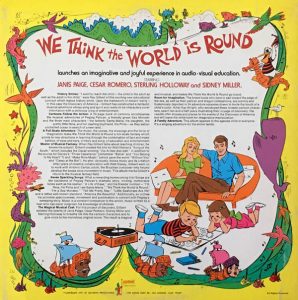 Oscar-winning Hollywood songwriter Ray Gilbert, who wrote all the songs for Hey There, It’s Yogi Bear (see this Spin), as well as the lyrics such songs as “The Three Caballeros” and “Zip-A-Dee-Doo-Dah” (for which he and composer Allie Wrubel shared the gold) had an idea for a children’s musical. Suppose the story of America’s discovery was told as a fantasy through the eyes of living ships?
Oscar-winning Hollywood songwriter Ray Gilbert, who wrote all the songs for Hey There, It’s Yogi Bear (see this Spin), as well as the lyrics such songs as “The Three Caballeros” and “Zip-A-Dee-Doo-Dah” (for which he and composer Allie Wrubel shared the gold) had an idea for a children’s musical. Suppose the story of America’s discovery was told as a fantasy through the eyes of living ships?
Today, many would add mention the whole story is already a fantasy, fraught with nagging “problematic concerns.” But in the mid-twentieth century, schools firmly insisted on 1492 being the year that “Columbus sailed the ocean blue to find this land for me and you.” Leif Erickson was also cited as being on the continent earlier on many occasions, but not always in schools, though this 1966 Flintstone children’s album gave him credit.)
For the purposes of this musical fairy tale, all the ships are the main characters. There is minimal mention of humans at all. Gilbert took this concept to family and friends to help make it happen. Chief among them was Del Connell, top Disney story artist, maquette sculptor and legendary Western Publishing comics writer/artist (Super Goof and Wacky Witch were among his creations). For the music, Gilbert called upon Ray Rasch, another Oscar winner for Chaplin’s 1952 feature, Limelight.
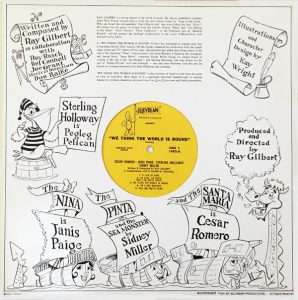 The very first result was a 1958 record album called The Nina, The Pinta and the Santa Maria, which is detailed further below. Over a decade later, Gilbert decided to re-record the album on a private label called “Jellybean Productions” (presumably his own with possible co-investors). It was renamed We Think the World is Round.
The very first result was a 1958 record album called The Nina, The Pinta and the Santa Maria, which is detailed further below. Over a decade later, Gilbert decided to re-record the album on a private label called “Jellybean Productions” (presumably his own with possible co-investors). It was renamed We Think the World is Round.
First billing on the 1971 album goes to movie star (and Gilbert’s wife) Janis Paige. She appeared in numerous classics like Romance on the High Seas with Doris Day and Silk Stockings with Fred Astaire and became the toast of Broadway in the musical hit The Pajama Game. All in the Family fans remember her as Archie Bunker’s flirtatious friend Denise (for which he wore his “good shirt from Disney World”).
Providing the singing for Nina is our beloved Robie Lester—Your Disneyland Story Reader; the singing voice of Eva Gabor in The Aristocats and The Rescuers; and Jessica in Santa Claus is Comin’ to Town. And speaking of that Rankin/Bass special, which is explored in this Spin, hearing her brilliant voice soar in Gilbert and Rasch’s ballad, “Tell Me Pretty Star,” it brings to mind her memorable performance of “My World is Beginning Today,” recorded only a short time earlier.
 Sidney Miller, a songwriting partner of Gilbert, was a child actor who became a director of such TV classics as Bewitched, The Monkees and The Mickey Mouse Club (he appeared on “Guest Star Day” too). Hollywood golden age leading man and baby boomer age Batman “Joker” Cesar Romero voices Santa Maria. Once again, Ray Gilbert gathered a star-studded group of friends to bring his pet project to life.
Sidney Miller, a songwriting partner of Gilbert, was a child actor who became a director of such TV classics as Bewitched, The Monkees and The Mickey Mouse Club (he appeared on “Guest Star Day” too). Hollywood golden age leading man and baby boomer age Batman “Joker” Cesar Romero voices Santa Maria. Once again, Ray Gilbert gathered a star-studded group of friends to bring his pet project to life.
To further the anthropomorphic idea of the ships, Nina is Santa Maria’s daughter and Pinta is her devoted boyfriend. Narrating the adventure, and providing Jiminy Cricket-like comic commentary, is Sterling Holloway as Pegleg Pelican.
Animator/Story Artist Kay Wright, whose career extended back to the days of Walt Disney’s Pinocchio joined the project to give a visual look to the story. The idea of producing it as an animated film may have been more of a possibility during this time, because the coloring book serves as a gallery of character designs and a storyboard of sorts.
Wright worked at several studios, but spent most of the seventies at Hanna-Barbera and the eighties at Filmation. This might account for the hybrid feeling of the designs. The boat faces in particular look very much like the Filmation house style. The Sea Monster harkens back to the Reluctant Dragon but could be a precursor to Elliott in Pete’s Dragon.
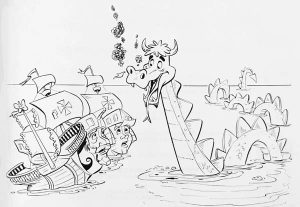 The third legendary name in the album credits played a role in this album as well: “collaborator” Joe Grant. Gilbert, Wright and Connell knew him from the early Disney feature era. The best guess for Grant’s contribution would be the concepts for Pegleg Pelican, since that is the only character who does not carry over from the 1958 album.
The third legendary name in the album credits played a role in this album as well: “collaborator” Joe Grant. Gilbert, Wright and Connell knew him from the early Disney feature era. The best guess for Grant’s contribution would be the concepts for Pegleg Pelican, since that is the only character who does not carry over from the 1958 album.
All of the movie-style orchestrated music comes from the 1958 Dot album, except for a few incidental music cues that could have been picked up from production libraries (tense keyboard sting, jazz over the mocking boats, and a chorus singing the public domain “America the Beautiful”).
Musical director Don Ralke’s other credits include arranging and conducting the Sherman Brothers score for Snoopy, Come Home (this Spin, Don Knott’s single version of “I Wish I Were a Fish” from The Incredible Mr. Limpet (this Spin), the Golden LP Dream Along with Bozo (this Spin) and William Shatner’s infamous “Transformed Man” album (but “I cannah write this Spin, Captain! The readers just cannah take it!”).

WE THINK THE WORLD IS ROUND
A Wild and Rollicking Fantasy with Songs, Four-Color Cartoons
and an Exciting Radio Play
Astor Music / BMG Kidz / Rincon Children’s Entertainment XE-2001 (Audio Cassette with Book / Mono)
Released in 1992. Producer/Director: Ray Gilbert. Story: Ray Gilbert, Joe Grant, Del Connell, Ray Rasch. Running Time: 25 minutes.
Voices: Sterling Holloway (Pegleg Pelican, Narrator); Janis Paige (Nina); Sidney Miller (Pinta, Sea Monster); Cesar Romero (Santa Maria); Robie Lester (Nina’s Singing Voice).
Songs: “A Life of Ease,” “I’m Nina, I’m Pinta and I Am Santa Maria,” “We Think the World is Round,” “I’m a Sea Monster,” “Tell Me Pretty Star,” “The Friendly Whales,” “The Storm,” “Little Sea Horses Are We” by Ray Gilbert, Ray Rasch.
Instrumental: “The Storm” by Ray Rasch.
By 1979, We Think the World is Round was produced as a 25-minute animated film, perfect for a TV special, but also submitted for Academy Award consideration. According to this Cartoon Research post by our own Jerry Beck, it was screened but did not make it into the finals.
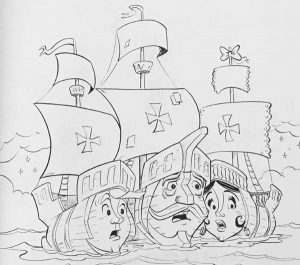 In 1992, Astor Music released it as a read-along book and cassette (but not as a vinyl record or compact disc) to coincide with broadcasts on the Disney Channel. The back cover of the package has historic significance in that bears the rare combination of both Disney and Hanna-Barbera corporate entities.
In 1992, Astor Music released it as a read-along book and cassette (but not as a vinyl record or compact disc) to coincide with broadcasts on the Disney Channel. The back cover of the package has historic significance in that bears the rare combination of both Disney and Hanna-Barbera corporate entities.
The film itself ends with a copyright notice by Rainbow Seven Productions (presumably another Gilbert partnership) but it became a Hanna-Barbera Presentation from Turner Entertainment (which had just purchased H-B). The VHS was released on Hanna-Barbera Home Video with a Hanna-Barbera copyright. An opening screen message announces that it is “An official licensed video of Spain-U.S.A. Quintennial,” because of 500 years since Columbus. (The explorer himself never appears in the animated film until briefly at the end, followed by the Epcot-like finale of the Apollo 11 moon landing.)
For the film’s soundtrack, the 1971 stereo album was mixed down to mono (Sterling Holloway’s direction for listeners to turn the record was of course removed). The audio on the read-along cassette is a direct lift from the film’s mono mix, so it lacks the crisp, clear quality of the 1971 vinyl. Astor added an introduction and a page-turning signal so kids could read along in the book. Cesar Romero’s ending speech with the moon landing was deleted, though it appears in the film.
The following is the completed version of We Think the World is Round as it appeared on Hanna-Barbera Home Video and the Disney Channel. It’s interesting to note the varying levels of animation, perhaps due to several breaks in the production over a period of time. The most fluid animation with the most detailed poses are in the Pegleg Pelican scenes, which are virtually independent to the other scenes. One wonders if Joe Grant was specifically involved with Pegleg’s development.
THE NINA, THE PINTA AND THE SANTA MARIA
A Musical Fantasy Starring Eddie Albert and Joanne Gilbert
Dot Records DLP-29009 (Stereo) DLP-9009) (Mono) (12” 33 rpm LP with Gatefold)
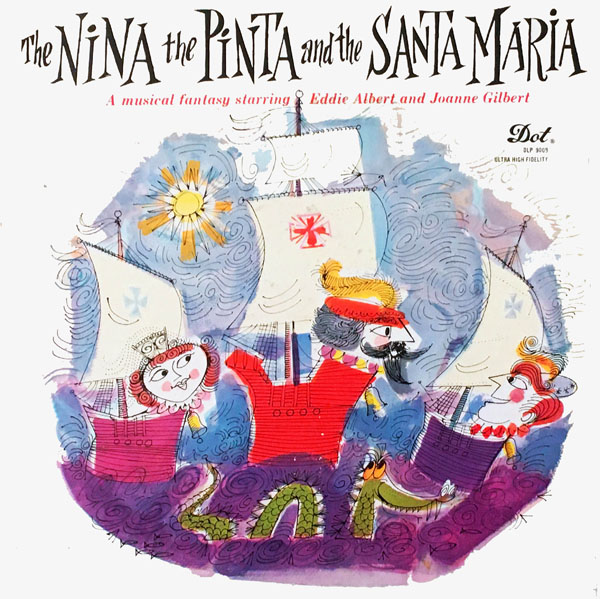
Released in 1958. Producer/Directors: Ray Gilbert, Tom Mack. Writer: Del Connell. Musical Director: Don Ralke. Music Supervisor: Neely Plumb. Running Time: 39 minutes.
Voices: Eddie Albert (Narrator, Sea Monster); Joanne Gilbert (Nina); Lee Millar (Pinta); Thurl Ravenscroft (Santa Maria).
Songs: “The Nina, The Pinta and The Santa Maria,” “We Think the World is Round,” “Sea Monster,” “Tell Me Pretty Star,” “Little Sea Horses” “Land A-Ho!” “America” by Ray Gilbert, Ray Rasch.
Instrumental: “The Storm” by Ray Rasch.
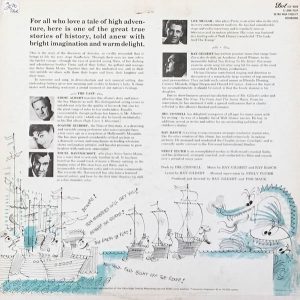 Like Mickey’s Christmas Carol, which was a record album long before it was an animated film, Ray Gilbert’s “talking boats discover America” musical story began its existence on vinyl.
Like Mickey’s Christmas Carol, which was a record album long before it was an animated film, Ray Gilbert’s “talking boats discover America” musical story began its existence on vinyl.
This lavish production of The Nina, the Pinta and the Santa Maria was supervised by veteran music executive Neely Plumb, whose countless credits include the 1965 RCA soundtrack album for The Sound of Music. That fact alone should make Jan Brady less envious of Marcia/Marcia/Marcia, because Eve Plumb, who played Jan on The Brady Bunch, is Neely’s daughter–so there. (Hey there groovy cats! Check out the boss Brady Spin rocking’ here!
As mentioned earlier, there is no pelican narrator in this version, but instead Eddie Albert—best known as Oliver Wendell Douglas on TV’s Green Acres—as the narrator and also the comical Sea Monster. Underlining the whimsical, outlandish nature of the premise, he begins the album with the words, “Once Upon a Time.”
Although the cast is different, there are still Disney ties. Disney Legend Thurl Ravenscroft (Tony the Tiger, Haunted Mansion singing bust, “You’re A Mean One, Mr. Grinch”) is the voice of Santa Maria and Lee Millar (voice of Tramp “Jim Dear” in Walt Disney’s Lady and the Tramp) plays Pinta. Ray Gilbert’s daughter Joanne, who had been making appearances in film and television at the time, speaks and sings as Nina. (Her original vocal of “Tell Me Pretty Star” is much slower in tempo than the later version, which might have been sped slightly to fit into the 25-minute time frame best suited to a possible cartoon. That could be why Robie Lester was brought in to sing it at the higher pitch.)
Del Connell is credited for the “book” (in musical terms, the script of the production), but not for the album art. His fans would immediately recognize his style in the drawings. Don Ralke is also not credited as Musical Director, though he would be on the 1971 album which used the same music, perhaps to correct the oversight. Plumb’s supervision role usually falls under administration rather than arranging, orchestrating and conducting.
Since Ray Gilbert carried this pet project around for so many years, the length and additional detail of this album suggests the theory that the musical might have been pitched as a feature. The three boats encounter a “mirage” made of clouds, Nina and Pinta are thought lost in the storm, and Santa Maria stays behind at the end of the story (the last of which is based on fact because the real Santa Maria could not make it back to Spain). None of these scenes ended up in 1971’s We Think the World is Round.



 GREG EHRBAR is a freelance writer/producer for television, advertising, books, theme parks and stage. Greg has worked on content for such studios as Disney, Warner and Universal, with some of Hollywood’s biggest stars. His numerous books include Mouse Tracks: The Story of Walt Disney Records (with Tim Hollis). Visit
GREG EHRBAR is a freelance writer/producer for television, advertising, books, theme parks and stage. Greg has worked on content for such studios as Disney, Warner and Universal, with some of Hollywood’s biggest stars. His numerous books include Mouse Tracks: The Story of Walt Disney Records (with Tim Hollis). Visit 





















































This is some wonderful music, and I’m especially impressed with the finely crafted orchestrations. There’s a sea horse farm in Tasmania, and if I ever go back there I’ll have to sing “Little Sea Horses Are We” and totally embarrass my wife.
I notice that Santa Maria was given the lines referring to faith, prayer and the Lord. Both Cesar Romero and Thurl Ravenscroft were devout Christians, so there was no violation of the third Commandment in either of these recordings.
I was going to point out that whales can’t really blow air out of their mouths; but in a story about talking ships, a sea serpent and a pelican with a prosthesis, why shouldn’t they?
Robie Lester is tops in my book… but why wouldn’t the very accomplished Janis Paige do her own singing on the 1971 album?
Lee Millar is the MASTER, JIM DEAR, NOT Tramp..Larry Roberts plays Tramp.:)
You are correct, sir! Wil fix that. Thank you!
To Greg:
I noted it was fixed.:)
Just to be a literal-minded spoilsport, I’m going to point out that all three ships have female names [translated as the Girl, the Painted Lady and Saint Mary], so it’s odd that the Pinta and the Santa Maria are played by male actors. Yeah, this is why I don’t have friends.
That also occurred to me, Doug, as well as the nautical convention of referring to ships by feminine pronouns. In German, names of ships always take the feminine article “die”, regardless of the nominal gender; for example, “eagle” is der Adler, but the battleship was die Adler. The same goes for ships named after men: die Graf Zeppelin, die Kaiser Wilhelm, und so weiter.
As for the fleet discussed above, I look at it this way: both Pinta and Santa Maria (sometimes spelled as one word, Santamaria) are genuine Spanish and Italian surnames, which, despite their gender, are passed down along the male line. (I’m not going to get into the issue of how a father ship can sire a daughter ship. I’ve heard of “sister ships”, but this is ridiculous.) As long as I’m cutting them slack for those mouth-breathing whales, I might as well let this slide, too.
You have friends here. After all, I’m still trying to happen upon a mermaid so I can ask her which brand of tuna fish I should buy.
Oh my God. I’ve had the 1958 version of album since I was a kid (I’m 57 now) and digitized it for my kids when they were growing up, twenty years ago. Now I’m putting it on a cassette tape for my grandson who has become enamored of the antique format, and while looking for the cover art found this page. Totally blows my mind. I’m hearing the original music mixed in with new overlaid tracks (the horns and guitar, vocals) and Pinta sounds more Spanish. If I grew up with this version (I was 7 when it was release) I imagine the older version would sound more stiff, but be amazed at the original, much like the two versions of Paul Tripp’s Billy on a Bike (I grew up with the newer one). Thanks for providing all the background info!
I remember by Dad and Ray worked closely together on this project and they formed Jellybean productions. There were many artists involved in the making of We think the world is round. there was no studio, all the animation was done at the different animators homes. My Dad was at filmation in the 70s and then spent the last 14 year’s of his career at Hanna Barbera as a producer.